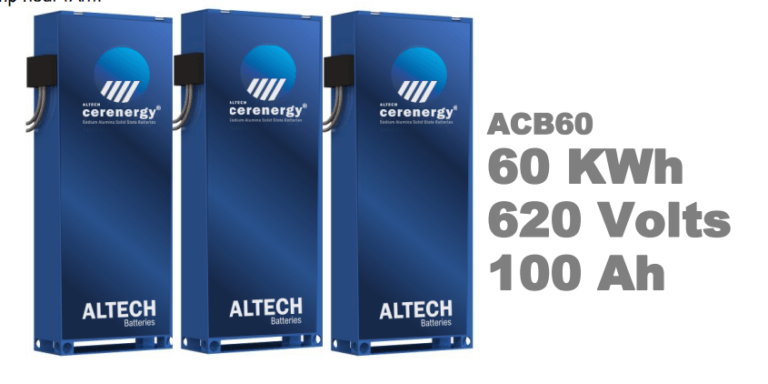Altech – launch of CERENERGY ® 60kwh battery pack (acb60) for the renewable energy storage market.
Altech Chemicals Limited (Altech/the Company) (ASX: ATC and FRA: A3Y) advises that, in connection with its battery joint venture with Fraunhofer, it has designed and launched the CERENERGY® Sodium Alumina Solid State (SAS) 60 KWh battery pack (ACB60) designed for the renewable energy and grid storage market.
Based on preliminary discussions with potential off-takers for the 100MWh CERENERGY® battery project, the proposed battery module for 10 kilowatt-hours (KWh) has been replaced by a 60 kilowatt-hour (KWh) battery pack (ACB60) with a higher rating. voltage of 620 volts and 100 amp hours (Ah).

Altech announced a JV Agreement with world-leading German battery institute Fraunhofer IKTS (“Fraunhofer”) to commercialize Fraunhofer’s revolutionary CERENERGY® Sodium Alumina Solid State (SAS) Battery. Altech, together with partner Altech Advanced Material AG, is the majority owner of 75% of the JV company, which will commercialize a 100 MWh project to be built on Altech’s land in Schwarze Pumpe, Germany.
CERENERGY® batteries are the game-changing grid storage alternative to lithium-ion batteries. CERENERGY® batteries are non-flammable and non-explosive; have a life span of over 15 years and operate in extreme cold and desert climates.
The battery technology uses table salt and no lithium; no cobalt; no graphite; and copper-free, eliminating exposure to critical metal price increases and supply chain concerns. The Altech-Fraunhofer joint venture is developing a 100 MWh SAS battery plant (Train 1) at Altech’s site in Saxony, Germany specifically focused on the grid (stationary) energy storage market.
The ACB60 battery pack will contain 240 CERENERGY® cells (rated at 2.5 V each) arranged in 4 rows of 12 cells, and 5 cell modules high. The battery packs have dimensions of 2.6m in length, 0.4m in height and 1.0m in width. The packages are designed for Ingress Protection (IP) 65 standard (levels of effectiveness for sealing electrical enclosures) which means they can be completely dustproof and weatherproof. Battery packs can be installed outdoors in all weather conditions.
The benefit of the larger ACB60 battery pack is that it will allow for more efficient installation in renewable energy storage and grid storage applications. Larger packages reduce module assembly casing and interconnect costs.
There is a cost advantage of using one Battery Management System (BMS) processor compared to six BMS processors for the previously envisioned individual 10 KWh modules. The fuse and disconnectors will also be reduced by the same factor for the larger 60 KWh battery.
The battery plant is now designed to produce 1,666 ACB60 battery packs per year (total 100 MWh) to start meeting the renewable energy and grid storage market in Europe.
Fraunhofer previously estimated that the cost of manufacturing CERENERGY® batteries should be in the region of 40% cheaper than lithium-ion batteries, mainly due to not requiring lithium, graphite, copper or cobalt. This can be confirmed in the Bankable Feasibility Study currently being conducted by Altech.
Renewable Energy and Grid Storage Applications
Renewable energy is being deployed all over the world. A new report shows that renewable energy sources are used to meet the increase in global electricity demand in the first half of 2022. Forecast reports also show that the grid storage market expected to grow at 28% CAGR in the coming decades. The global battery energy storage systems market is expected to grow from USD 4.4 billion in 2022 to USD 15.1 billion in 2027.
Or more, growth is expected from 20 GW in 2020 to more than 3,000 GW in 2050. SAS batteries can provide high security with low acquisition and operating costs for a stationary market. to save energy. Combining wind and solar with battery storage offers many advantages.
The Wheatridge Renewable Energy Project in Oregon is a typical example of how combining renewable energy sources with battery storage can help provide reliable, sustainable energy as utility companies look to reduce carbon emissions. In these types of applications, many battery systems are installed near solar and wind farms.
Generally, lithium-ion batteries are often used by utilities to store renewable energy when the sun goes down or the wind stops blowing. However, existing utility-scale storage can only discharge energy for up to four hours at a time, meaning the systems cannot provide widespread power for longer periods of time (for example: during at night). There is a need for medium and long duration batteries that provide continuous power for a longer period of time.
Altech’s CERENERGY® ACB60 battery packs are designed to fill this gap. The newly designed Altech ACB60 battery packs are expected to take 6 hours to charge and discharge in the same amount of time. However, they have the capacity to discharge quickly, in less than 3 hours if needed.
These battery packs charging and discharging characteristics match more closely the power generation patterns of the sun. The Altech design team will advance the heat transfer modeling and optimize the insulation design next.
Altech Chemicals Interactive Investor Hub
Engage directly with Altech by asking questions, watching video summaries and seeing what other shareholders have to say about it, as well as previous announcements, in our Investor Hub https:// investorhub.altechchemicals.com
Highlights:
- Launch of ACB60 60 KWh sodium alumina solid state battery pack
- Rated at 620 Volts and 100 Ah
- Specially designed for the renewable energy and grid storage market
- Each ACB60 battery pack contains 240 cells
- Fully weatherproof design for outdoor installation
- The larger ACB60 pack reduces module assembly and interconnect costs
read the latest Battery News shaping the battery market
ALTECH – LAUNCH OF CERENERGY® 60KWh BATTERY PACK (ACB60) FOR NEW ENERGY STORAGE BRAND, November 2022
